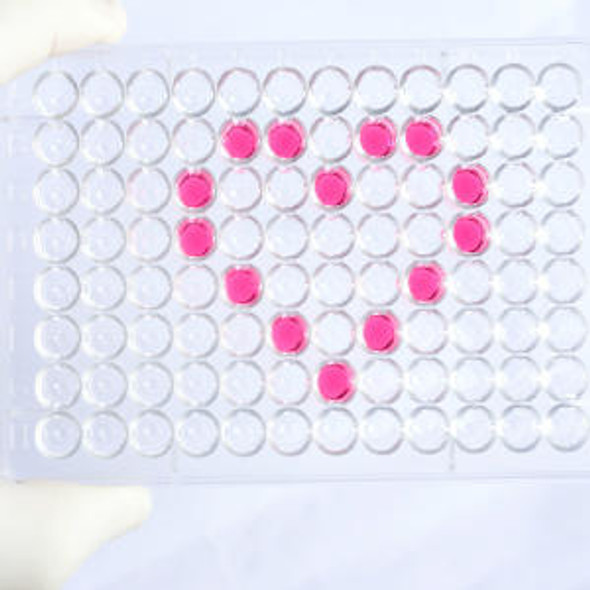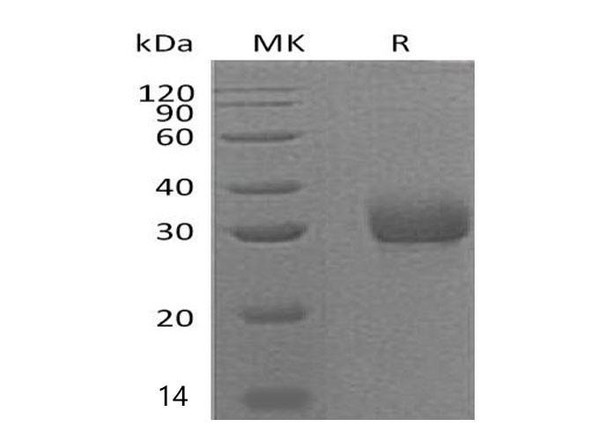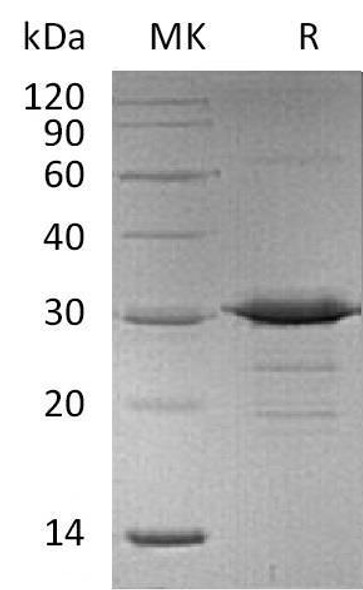Mouse Cell Biology ELISA Kits 2
Mouse Adiponectin (Adipoq) ELISA Kit
- SKU:
- MOEB0486
- Product Type:
- ELISA Kit
- Size:
- 96 Assays
- Uniprot:
- Q60994
- Range:
- 0.156-10 ng/mL
- ELISA Type:
- Sandwich
- Synonyms:
- Adiponectin, AdipoQ, ADP, Acrp30, GBP28, ACDC, ADPN
- Reactivity:
- Mouse
Description
| Product Name: | Mouse Adiponectin (Adipoq) ELISA Kit |
| Product Code: | MOEB0486 |
| Alias: | Adiponectin, 30 kDa adipocyte complement-related protein, Adipocyte complement-related 30 kDa protein, ACRP30, Adipocyte, C1q and collagen domain-containing protein, Adipocyte-specific protein AdipoQ, Adipoq, Acdc, Acrp30, Apm1 |
| Uniprot: | Q60994 |
| Reactivity: | Mouse |
| Range: | 0.156-10 ng/mL |
| Detection Method: | Sandwich |
| Size: | 96 Assay |
| Storage: | Please see kit components below for exact storage details |
| Note: | For research use only |
| UniProt Protein Function: | adiponectin: Important adipokine involved in the control of fat metabolism and insulin sensitivity, with direct anti-diabetic, anti-atherogenic and anti-inflammatory activities. Stimulates AMPK phosphorylation and activation in the liver and the skeletal muscle, enhancing glucose utilization and fatty-acid combustion. Antagonizes TNF-alpha by negatively regulating its expression in various tissues such as liver and macrophages, and also by counteracting its effects. Inhibits endothelial NF-kappa-B signaling through a cAMP-dependent pathway. May play a role in cell growth, angiogenesis and tissue remodeling by binding and sequestering various growth factors with distinct binding affinities, depending on the type of complex, LMW, MMW or HMW. Homomultimer. Forms trimers, hexamers and 12- to 18-mers. The trimers (low molecular weight complexes / LMW) are assembled via non-covalent interactions of the collagen-like domains in a triple helix and hydrophobic interactions within the globular C1q domain. Several trimers can associate to form disulfide-linked hexamers (middle molecular weight complexes / MMW) and larger complexes (higher molecular weight / HMW). The HMW-complex assembly may rely aditionally on lysine hydroxylation and glycosylation. LMW, MMW and HMW complexes bind to HBEGF, MMW and HMW complexes bind to PDGFB, and HMW complex binds to FGF2. Interacts with CTRP9A via the C1q domain (heterotrimeric complex). Synthesized exclusively by adipocytes and secreted into plasma. |
| UniProt Protein Details: | Protein type:Secreted, signal peptide; Endoplasmic reticulum; Hormone; Secreted Cellular Component: extracellular space; cell surface; collagen; protein complex; endoplasmic reticulum; extracellular region Molecular Function:identical protein binding; protein binding; protein homodimerization activity; hormone activity; sialic acid binding; receptor binding Biological Process: negative regulation of MAP kinase activity; negative regulation of phagocytosis; negative regulation of smooth muscle cell proliferation; negative regulation of hormone secretion; positive regulation of cellular protein metabolic process; membrane hyperpolarization; negative regulation of smooth muscle cell migration; glucose homeostasis; negative regulation of granulocyte differentiation; positive regulation of interleukin-8 production; positive regulation of glucose import; negative regulation of gluconeogenesis; response to glucose stimulus; adiponectin-mediated signaling pathway; negative regulation of protein amino acid autophosphorylation; negative regulation of blood pressure; negative regulation of cell migration; protein homooligomerization; positive regulation of I-kappaB kinase/NF-kappaB cascade; negative regulation of heterotypic cell-cell adhesion; positive regulation of signal transduction; glucose metabolic process; negative regulation of tumor necrosis factor production; negative regulation of I-kappaB kinase/NF-kappaB cascade; negative regulation of fat cell differentiation; negative regulation of synaptic transmission; membrane depolarization; positive regulation of peptidyl-tyrosine phosphorylation; positive regulation of fatty acid metabolic process; fatty acid beta-oxidation; negative regulation of macrophage differentiation; cellular response to insulin stimulus; negative regulation of low-density lipoprotein receptor biosynthetic process; positive regulation of protein kinase activity; negative regulation of inflammatory response; brown fat cell differentiation; fatty acid oxidation; positive regulation of protein amino acid phosphorylation; negative regulation of transcription, DNA-dependent; positive regulation of myeloid cell apoptosis; positive regulation of blood pressure |
| UniProt Code: | Q60994 |
| NCBI GenInfo Identifier: | 408359957 |
| NCBI Gene ID: | 11450 |
| NCBI Accession: | Q60994.2 |
| UniProt Secondary Accession: | Q60994,Q62400, Q6GTX4, Q9DC68, |
| UniProt Related Accession: | Q60994 |
| Molecular Weight: | 26,809 Da |
| NCBI Full Name: | Adiponectin |
| NCBI Synonym Full Names: | adiponectin, C1Q and collagen domain containing |
| NCBI Official Symbol: | Adipoq |
| NCBI Official Synonym Symbols: | APN; Acdc; apM1; 30kDa; GBP28; adipo; Acrp30 |
| NCBI Protein Information: | adiponectin; adipocyte-specific protein AdipoQ; adipocyte complement related protein; 30 kDa adipocyte complement-related protein; adipocyte complement-related 30 kDa protein; adipocyte, C1Q and collagen domain containing; adipocyte, C1q and collagen domain-containing protein |
| UniProt Protein Name: | Adiponectin |
| UniProt Synonym Protein Names: | 30 kDa adipocyte complement-related protein; Adipocyte complement-related 30 kDa protein; ACRP30; Adipocyte, C1q and collagen domain-containing protein; Adipocyte-specific protein AdipoQ |
| Protein Family: | Adiponectin |
| UniProt Gene Name: | Adipoq |
| UniProt Entry Name: | ADIPO_MOUSE |
| Component | Quantity (96 Assays) | Storage |
| ELISA Microplate (Dismountable) | 8×12 strips | -20°C |
| Lyophilized Standard | 2 | -20°C |
| Sample Diluent | 20ml | -20°C |
| Assay Diluent A | 10mL | -20°C |
| Assay Diluent B | 10mL | -20°C |
| Detection Reagent A | 120µL | -20°C |
| Detection Reagent B | 120µL | -20°C |
| Wash Buffer | 30mL | 4°C |
| Substrate | 10mL | 4°C |
| Stop Solution | 10mL | 4°C |
| Plate Sealer | 5 | - |
Other materials and equipment required:
- Microplate reader with 450 nm wavelength filter
- Multichannel Pipette, Pipette, microcentrifuge tubes and disposable pipette tips
- Incubator
- Deionized or distilled water
- Absorbent paper
- Buffer resevoir
*Note: The below protocol is a sample protocol. Protocols are specific to each batch/lot. For the correct instructions please follow the protocol included in your kit.
Allow all reagents to reach room temperature (Please do not dissolve the reagents at 37°C directly). All the reagents should be mixed thoroughly by gently swirling before pipetting. Avoid foaming. Keep appropriate numbers of strips for 1 experiment and remove extra strips from microtiter plate. Removed strips should be resealed and stored at -20°C until the kits expiry date. Prepare all reagents, working standards and samples as directed in the previous sections. Please predict the concentration before assaying. If values for these are not within the range of the standard curve, users must determine the optimal sample dilutions for their experiments. We recommend running all samples in duplicate.
| Step | |
| 1. | Add Sample: Add 100µL of Standard, Blank, or Sample per well. The blank well is added with Sample diluent. Solutions are added to the bottom of micro ELISA plate well, avoid inside wall touching and foaming as possible. Mix it gently. Cover the plate with sealer we provided. Incubate for 120 minutes at 37°C. |
| 2. | Remove the liquid from each well, don't wash. Add 100µL of Detection Reagent A working solution to each well. Cover with the Plate sealer. Gently tap the plate to ensure thorough mixing. Incubate for 1 hour at 37°C. Note: if Detection Reagent A appears cloudy warm to room temperature until solution is uniform. |
| 3. | Aspirate each well and wash, repeating the process three times. Wash by filling each well with Wash Buffer (approximately 400µL) (a squirt bottle, multi-channel pipette,manifold dispenser or automated washer are needed). Complete removal of liquid at each step is essential. After the last wash, completely remove remaining Wash Buffer by aspirating or decanting. Invert the plate and pat it against thick clean absorbent paper. |
| 4. | Add 100µL of Detection Reagent B working solution to each well. Cover with the Plate sealer. Incubate for 60 minutes at 37°C. |
| 5. | Repeat the wash process for five times as conducted in step 3. |
| 6. | Add 90µL of Substrate Solution to each well. Cover with a new Plate sealer and incubate for 10-20 minutes at 37°C. Protect the plate from light. The reaction time can be shortened or extended according to the actual color change, but this should not exceed more than 30 minutes. When apparent gradient appears in standard wells, user should terminatethe reaction. |
| 7. | Add 50µL of Stop Solution to each well. If color change does not appear uniform, gently tap the plate to ensure thorough mixing. |
| 8. | Determine the optical density (OD value) of each well at once, using a micro-plate reader set to 450 nm. User should open the micro-plate reader in advance, preheat the instrument, and set the testing parameters. |
| 9. | After experiment, store all reagents according to the specified storage temperature respectively until their expiry. |
When carrying out an ELISA assay it is important to prepare your samples in order to achieve the best possible results. Below we have a list of procedures for the preparation of samples for different sample types.
| Sample Type | Protocol |
| Serum | If using serum separator tubes, allow samples to clot for 30 minutes at room temperature. Centrifuge for 10 minutes at 1,000x g. Collect the serum fraction and assay promptly or aliquot and store the samples at -80°C. Avoid multiple freeze-thaw cycles. If serum separator tubes are not being used, allow samples to clot overnight at 2-8°C. Centrifuge for 10 minutes at 1,000x g. Remove serum and assay promptly or aliquot and store the samples at -80°C. Avoid multiple freeze-thaw cycles. |
| Plasma | Collect plasma using EDTA or heparin as an anticoagulant. Centrifuge samples at 4°C for 15 mins at 1000 × g within 30 mins of collection. Collect the plasma fraction and assay promptly or aliquot and store the samples at -80°C. Avoid multiple freeze-thaw cycles. Note: Over haemolysed samples are not suitable for use with this kit. |
| Urine & Cerebrospinal Fluid | Collect the urine (mid-stream) in a sterile container, centrifuge for 20 mins at 2000-3000 rpm. Remove supernatant and assay immediately. If any precipitation is detected, repeat the centrifugation step. A similar protocol can be used for cerebrospinal fluid. |
| Cell culture supernatant | Collect the cell culture media by pipette, followed by centrifugation at 4°C for 20 mins at 1500 rpm. Collect the clear supernatant and assay immediately. |
| Cell lysates | Solubilize cells in lysis buffer and allow to sit on ice for 30 minutes. Centrifuge tubes at 14,000 x g for 5 minutes to remove insoluble material. Aliquot the supernatant into a new tube and discard the remaining whole cell extract. Quantify total protein concentration using a total protein assay. Assay immediately or aliquot and store at ≤ -20 °C. |
| Tissue homogenates | The preparation of tissue homogenates will vary depending upon tissue type. Rinse tissue with 1X PBS to remove excess blood & homogenize in 20ml of 1X PBS (including protease inhibitors) and store overnight at ≤ -20°C. Two freeze-thaw cycles are required to break the cell membranes. To further disrupt the cell membranes you can sonicate the samples. Centrifuge homogenates for 5 mins at 5000xg. Remove the supernatant and assay immediately or aliquot and store at -20°C or -80°C. |
| Tissue lysates | Rinse tissue with PBS, cut into 1-2 mm pieces, and homogenize with a tissue homogenizer in PBS. Add an equal volume of RIPA buffer containing protease inhibitors and lyse tissues at room temperature for 30 minutes with gentle agitation. Centrifuge to remove debris. Quantify total protein concentration using a total protein assay. Assay immediately or aliquot and store at ≤ -20 °C. |
| Breast Milk | Collect milk samples and centrifuge at 10,000 x g for 60 min at 4°C. Aliquot the supernatant and assay. For long term use, store samples at -80°C. Minimize freeze/thaw cycles. |






